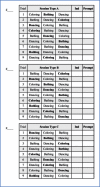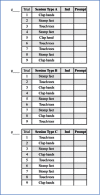Teaching receptive language skills: recommendations for instructors
- PMID: 25729507
- PMCID: PMC3680153
- DOI: 10.1007/BF03391791
Teaching receptive language skills: recommendations for instructors
Abstract
Receptive language refers to responding appropriately to another person's spoken language. Most curricula dedicate a proportion of early intervention to developing receptive language skills. The specific terms used to refer to the receptive language programs and the recommendations for teaching such skills vary considerably across the early intervention curricula. The present paper will provide a conceptual analysis of the desired controlling variables for different receptive language programs, teaching recommendations, a brief review of the literature to substantiate the teaching recommendations, and a discussion of the potential negative effects of deviating from the recommendations.
Keywords: autism; developmental disabilities; early intervention; instructional strategies; listener behavior; receptive language.
Figures



Similar articles
-
A review of recommendations for sequencing receptive and expressive language instruction.J Appl Behav Anal. 2011 Winter;44(4):859-76. doi: 10.1901/jaba.2011.44-859. J Appl Behav Anal. 2011. PMID: 22219535 Free PMC article. Review.
-
Designing Receptive Language Programs: Pushing the Boundaries of Research and Practice.Behav Anal Pract. 2018 Jan 29;11(4):479-495. doi: 10.1007/s40617-018-0208-1. eCollection 2018 Dec 31. Behav Anal Pract. 2018. PMID: 30538924 Free PMC article.
-
The effects of receptive and expressive instructional sequences on varied conditional discriminations.J Appl Behav Anal. 2017 Oct;50(4):775-788. doi: 10.1002/jaba.404. Epub 2017 Aug 21. J Appl Behav Anal. 2017. PMID: 28833111
-
Erratum: Involving Individuals with Developmental Language Disorder and their Parents/Carers in Research Priority Setting.J Vis Exp. 2020 Oct 19;(164). doi: 10.3791/6451. J Vis Exp. 2020. PMID: 33074253
-
Recent research on the relative efficiency of speaker and listener instruction for children with autism spectrum disorder.J Appl Behav Anal. 2020 Jan;53(1):584-589. doi: 10.1002/jaba.543. Epub 2019 Jan 30. J Appl Behav Anal. 2020. PMID: 30701539 Review.
Cited by
-
Developing and Implementing Emergent Responding Training Systems With Available and Low-Cost Computer-Based Learning Tools: Some Best Practices and a Tutorial.Behav Anal Pract. 2019 Dec 20;13(2):509-520. doi: 10.1007/s40617-019-00405-x. eCollection 2020 Jun. Behav Anal Pract. 2019. PMID: 32647608 Free PMC article.
-
Comparison of Enhanced and Standard Data Sheets on Treatment Fidelity and Data Collection for Tact Training.Behav Anal Pract. 2023 Oct 25;17(2):533-543. doi: 10.1007/s40617-023-00869-y. eCollection 2024 Jun. Behav Anal Pract. 2023. PMID: 38966279 Free PMC article.
-
Evaluating Three Methods of Stimulus Rotation when Teaching Receptive Labels.Behav Anal Pract. 2018 Apr 17;11(4):334-349. doi: 10.1007/s40617-018-0249-5. eCollection 2018 Dec 31. Behav Anal Pract. 2018. PMID: 30538907 Free PMC article.
-
Using PowerPoint 2016 to Create Individualized Matching to Sample Sessions.Behav Anal Pract. 2018 Jul 2;12(2):483-490. doi: 10.1007/s40617-018-0223-2. eCollection 2019 Jun. Behav Anal Pract. 2018. PMID: 31976256 Free PMC article.
-
An Evaluation of Differential Observing Responses During Receptive Label Training.Behav Anal Pract. 2017 Apr 24;10(3):290-295. doi: 10.1007/s40617-017-0188-6. eCollection 2017 Sep. Behav Anal Pract. 2017. PMID: 29021941 Free PMC article.
References
-
- Allen K. D., Fuqua R. W. Eliminating selective stimulus control: A comparison of two procedures for teaching mentally retarded children to respond to compound stimuli. Journal of Experimental Child Psychology. 1985;39:55–71. - PubMed
-
- Barbera M. L. The verbal behavior approach. Philadelphia, PA: Jessica Kingsley Publishers; 2007.
-
- Bonta J. L., Waters R. G. Use of manual signs in delayed matching-to-sample with developmentally disordered, speech deficient children. Behavior Research of Severe Developmental Disabilities. 1981;2:51–66.
-
- Cannella H. I., O'Reilly M. F., Lancioni G. E. Choice and preference assessment research with people with severe to profound developmental disabilities: A review of the literature. Research in Developmental Disabilities. 2005;26:1–15. - PubMed
LinkOut - more resources
Full Text Sources
Other Literature Sources
